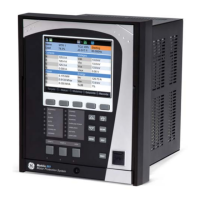CHAPTER 4: SETPOINTS SYSTEM
869 MOTOR PROTECTION SYSTEM – INSTRUCTION MANUAL 4–65
For example, on a system of 13.8kV nominal primary voltage, and a 14400:120 volt VT in a
Delta connection, the secondary voltage would be 115V, i.e. (13800/14400)*120. For a Wye
connection, the voltage value entered must be the phase to neutral voltage which would
be 115/√3 = 66.4 V.
On a 14.4 kV system with a Delta connection and a VT primary to secondary turns ratio of
14400:120, the voltage value entered would be 120 V, i.e. 14400/120.
Power System
Path:
Setpoints > System > Power System
NOMINAL FREQUENCY
Range: 60 Hz, 50 Hz
Default: 60 Hz
The power system NOMINAL FREQUENCY is used as a default to set the digital sampling
rate if the system frequency cannot be measured from available AC signals. This may
happen if the signals selected for frequency tracking are not present, or a valid
frequency is not detected. Before reverting to the nominal frequency, the frequency
tracking algorithm holds the last valid frequency measurement for a safe period of time
while waiting for the signals to reappear or for the distortions to decay.
FREQUENCY TRACKING
Range: Disabled, Enabled
Default: Enabled
The frequency reference is provided by composite signal derived by the Clarke
transformation (V
FREQUENCY
= (2V
A
– V
B
– V
C
) / 3) for better performance during fault,
open pole, and VT and CT fail conditions.
• If present, the three-phase voltages are used for frequency tracking. Phase A voltage
is used as a phase
reference.
• Frequency tracking is switched automatically by an algorithm, to the three-phase
curr
ents (or auxiliary voltage signal for the tie-breaker configuration), if the frequency
detected from the three-phase voltage inputs is declared invalid. The switching is not
performed if the frequency from the alternative reference signal is detected invalid.
• Upon detecting valid frequency on the main frequency and phase reference signal,
track
ing is switched back to that reference.
FAST PATH:
FREQUENCY TRACKING should be set to “Disabled” only under very unusual circumstances.
Consult the factory for special variable-frequency applications.

